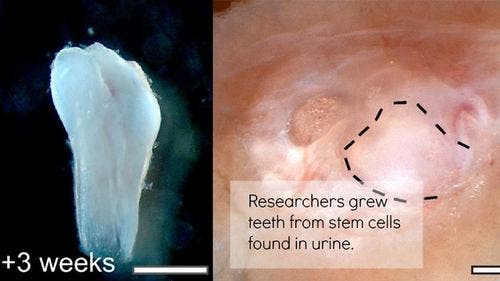
Some of you might find it weird that someone would use cells from urine for organ generation, considering there might be other more interesting sources at hand – previous research showed, however, that it is indeed feasible to generate cells from urine. Also, cells discarded with urea have been made into induced pluripotent stem cells (iPSCs) – a sort of adult stem cells – that can be used to generate just about any type of tissue, from neurons to muscles.
Duanqing Pei and his colleagues from Guangzhou Institutes of Biomedicine and Health used such iPSCs derived from urine to a tissue culture system that eventually went on to resemble the shape and structure of human teeth. But first the team used chemicals to coax the cultured iPSCs into flat sheets of epithelial cells, which they then mixed with mouse embryonic mesenchymal cells, and transplanted them into mice.

Three weeks later, formations had grown that physically and structurally resembled human teeth that have many of the qualities of human teeth: elasticity, pulp, dentin, and enamel-forming cells. There are some serious drawbacks to their method, however. First off, the success rate is of only 30% and the resulting teeth are about a third as hard as human teeth.
Using human cells instead of mouse cells might help resolve this issues and help researchers finally completely regenerate human teeth for clinical therapy – a lifelong dream for many involves in such work. And if the patient’s own cells were used, the risk of rejection by the body is negated.
The research whose findings were recently published in the journal Cell Regeneration, is the latest in a slew of advances that make use of induced pluripotent stem cells to generate human compatible tissue, bringing regenerative medicine back in the spotlight. For instance, ZME Science recently reported how scientists used iPSCs to grow a liver, functioning blood cells, and even mice from dish-cultured sperm and egg.
For many years stem cells were viewed with somewhat skepticism since they’re so difficult to come by and, of course, the controversy surrounding embryo use. Induced pluripotent stem cells solve the classic drawbacks of stem cells simply by avoid them and can come from readily accessible sources like skin, blood or just about any adult cell in a host body. As you’ve learned, even cells from urine can make due. Furthermore, cells generated by this method cannot be rejected by the human immune system, being derived from the host’s own cellular material.






